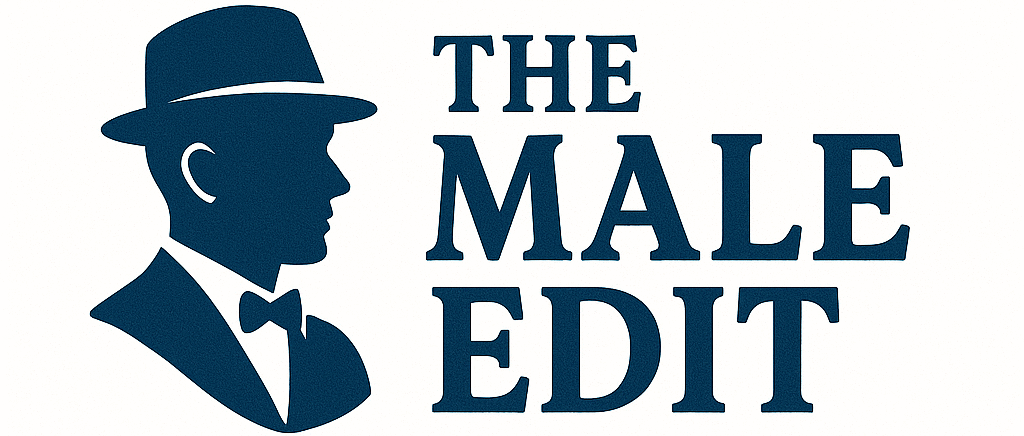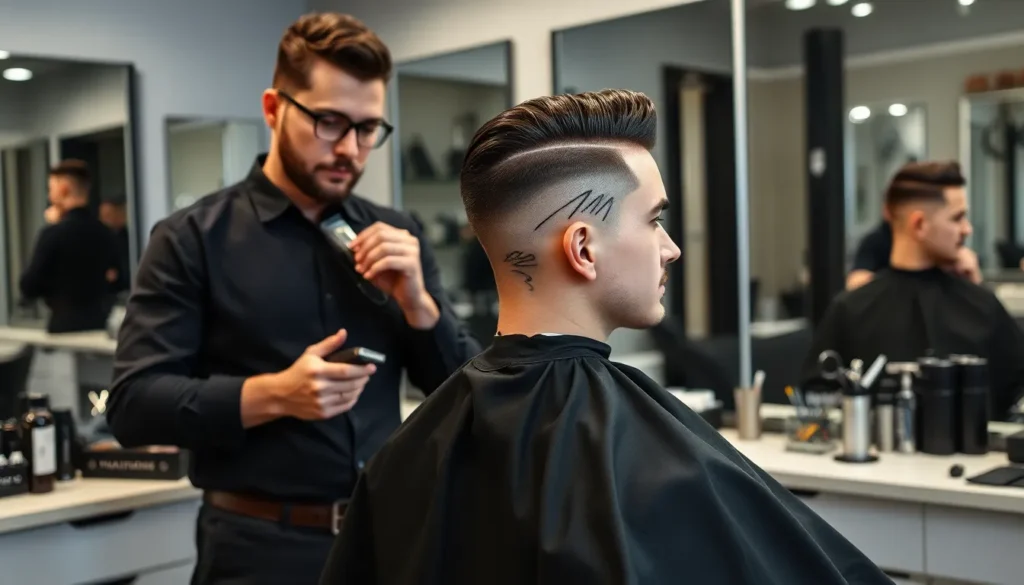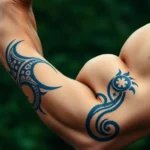Modern men’s grooming has evolved far beyond basic cuts and we’re witnessing a revolution in creative hair artistry. Line designs have emerged as the ultimate way to add personality and edge to any haircut turning heads wherever you go.
From subtle geometric patterns to bold racing stripes these precision-cut details transform ordinary hairstyles into statement pieces. Whether you’re looking to enhance your fade add visual interest to your sides or create a completely unique look line designs offer endless possibilities for self-expression.
We’ve curated the most striking line design ideas that’ll elevate your style game and keep you ahead of the grooming curve. These aren’t just haircuts – they’re artistic statements that showcase your confidence and attention to detail.
Classic Line-Up Cuts That Never Go Out of Style
These timeless line-up styles form the foundation of exceptional men’s grooming, delivering crisp precision that transcends fleeting trends.
The Traditional Straight Edge Line-Up
Sharp hairline precision defines this cornerstone technique that barbers have perfected over decades. We recommend this cut for men seeking clean geometric edges around their natural hairline without dramatic alterations. The straight edge approach creates a rectangular frame around the forehead, emphasizing facial structure through deliberate angular lines.
Professional barbers use specialized clippers and razors to achieve the razor-sharp edges that characterize this style. We’ve observed that maintenance requires visits every 2-3 weeks to preserve the crisp definition. This classic approach works exceptionally well with short to medium length hair on top, particularly buzz cuts and crew cuts.
Styling versatility makes this line-up incredibly adaptable to various face shapes and hair textures. We notice that men with naturally straight hairlines benefit most from this technique, as it enhances existing symmetry rather than creating artificial angles.
The Clean Temple Fade with Sharp Lines
Temple fades combined with precise line work create one of our most requested contemporary classics. We execute this style by gradually blending hair from the temples down to the skin, then adding sharp linear definition along the hairline edges. The contrast between the soft fade and crisp lines produces visual depth that flatters most face shapes.
Strategic line placement enhances the fade’s natural flow while maintaining clean architectural elements. We typically incorporate straight lines above the ears and curved lines that follow the natural hairline contour. This combination technique requires advanced clipper skills and steady hands for optimal results.
Maintenance schedules vary based on hair growth patterns, but we generally recommend touch-ups every 10-14 days. The fade portion grows out more gradually than the sharp lines, allowing for extended wear between appointments.
The Classic Caesar Cut with Defined Hairline
Caesar cuts receive dramatic enhancement through strategic hairline definition that sharpens the overall silhouette. We create this look by maintaining the traditional forward-combed Caesar length while adding precise linear edges around the perimeter. The defined hairline transforms this ancient Roman inspired style into a modern grooming statement.
Textural contrast becomes the focal point when we pair the Caesar’s naturally tousled appearance with laser-sharp edge work. We find that this combination works particularly well for men with thicker hair textures that can support both the volume on top and the clean lines below.
Styling requires minimal daily effort once the initial cut is properly executed. We suggest using light-hold styling products to maintain the forward sweep while keeping the defined edges visible and prominent.
Modern Geometric Line Designs for Contemporary Men

Contemporary line designs push creative boundaries by incorporating sharp angles and precise geometric shapes that transform standard cuts into artistic statements. We’re seeing men embrace these bold patterns that use mathematical precision to create eye-catching visual effects.
Angular Side Part with Precision Lines
Angular side parts with precision lines merge traditional sophistication with contemporary edge work. This sophisticated design maintains the classic side part’s clean foundation while adding geometric lines that follow the head’s natural contours. We recommend this style for men who want professional polish with artistic flair, as the precision lines emphasize the parting while creating structured visual interest.
The technique requires expert barber skills to achieve the sharp angles that define this look. Professional stylists etch these geometric lines directly into the hair, creating contrast that highlights the angular side part’s natural flow. Men with straight to slightly wavy hair textures achieve the best results with this design.
Geometric Undercut Patterns
Geometric undercut patterns showcase intricate designs shaved into ultra-short sides and back sections. These bold creations feature complex angular shapes, repeating triangular motifs, and intersecting lines that demonstrate artistic precision. We’ve observed that geometric undercuts work exceptionally well when paired with longer top lengths, creating maximum visual contrast.
The versatility of geometric patterns allows for personalization through various design elements. Simple straight line combinations offer subtle sophistication, while complex angular arrangements make dramatic statements. Professional barbers can customize these patterns to match individual style preferences and head shapes.
Regular maintenance becomes essential with geometric undercuts, as growing hair quickly blurs the sharp definition. We suggest scheduling touch-up appointments every 2-3 weeks to maintain the crisp edges that make these designs impactful.
Abstract Linear Designs on Faded Sides
Abstract linear designs combine artistic freedom with technical fading skills to create unique asymmetrical patterns. These creative expressions feature irregular lines, broken segments, and flowing curves that contrast beautifully against gradient fade backgrounds. We appreciate how abstract designs offer more artistic flexibility compared to rigid geometric patterns.
The fading technique provides the perfect canvas for abstract line work, creating depth that makes linear designs visually pop. Skilled barbers can incorporate fluid curves, disconnected segments, and varying line weights to achieve truly personalized results. This approach suits men seeking distinctive styles that balance creativity with modern sophistication.
Abstract linear designs work particularly well for men with round or oval face shapes, as the asymmetrical elements add visual interest without overwhelming facial features. We recommend discussing design concepts with experienced barbers who specialize in artistic hair work to achieve optimal results.
Creative Zigzag and Wave Line Patterns
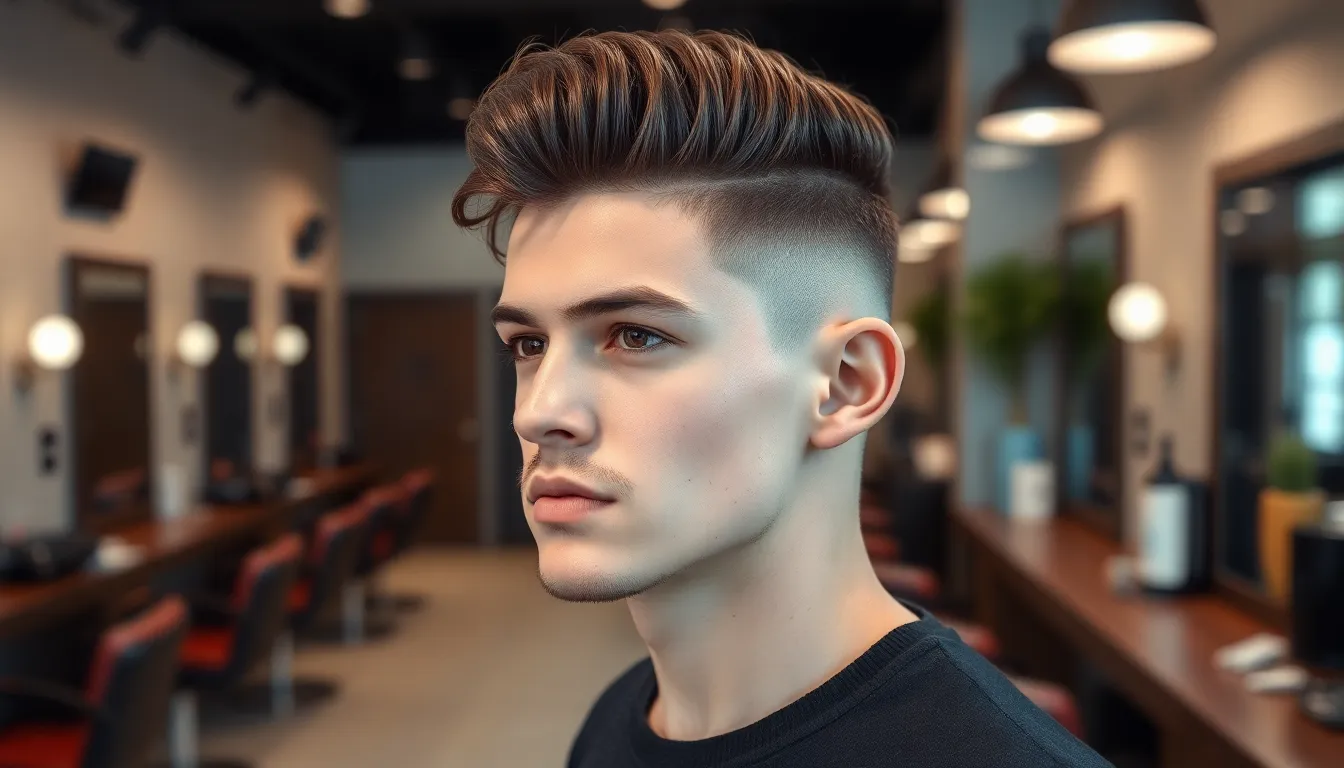
Creative zigzag and wave line patterns represent the most ever-changing expressions in contemporary men’s hair design. These flowing and angular designs transform standard cuts into eye-catching artistic statements that showcase personality and style confidence.
Zigzag Temple Lines for Bold Statement
Zigzag temple lines create powerful visual impact by incorporating sharp angular patterns along the temple area. These bold designs work exceptionally well with fade cuts and undercuts, adding geometric interest to otherwise simple styles. Barbers achieve this look by carefully shaving alternating angles that create the distinctive zigzag effect.
The pattern works best on men with medium to thick hair density, as the contrast between shaved and unshaved areas becomes more pronounced. We recommend starting with wider zigzag patterns for first-time wearers, then gradually experimenting with tighter angles for more dramatic effects. This design requires touch-ups every 7-10 days to maintain its crisp appearance and prevent the pattern from blurring as hair grows.
Ocean Wave Designs Along the Hairline
Ocean wave designs involve creating flowing curved patterns along the natural hairline that mimic water movement. These designs add ever-changing visual elements to fade and undercut styles while maintaining a sophisticated appearance. The wave patterns can range from subtle single waves to complex multi-layered designs that wrap around the head.
Skilled barbers use specialized clippers and razors to create the smooth flowing lines that characterize this style. The design works particularly well for men with naturally curved hairlines, as it enhances existing features rather than fighting against them. We suggest discussing wave depth and frequency with your barber to ensure the design complements your face shape and hair growth patterns.
Lightning Bolt Side Patterns
Lightning bolt side patterns feature sharp, jagged lines that create dramatic angular designs reminiscent of electrical bolts. These eye-catching patterns work best when placed on the sides of the head, creating striking contrast against faded or closely cropped areas. The design requires precise clipper work to achieve the characteristic sharp points and dramatic angles.
This bold pattern suits men who want maximum visual impact from their haircut design. The lightning bolt can be customized in terms of size, angle, and complexity, allowing for personalized interpretations of the concept. We recommend pairing this design with longer hair on top to create balance and prevent the overall look from becoming too aggressive.
Minimalist Single Line Accent Cuts
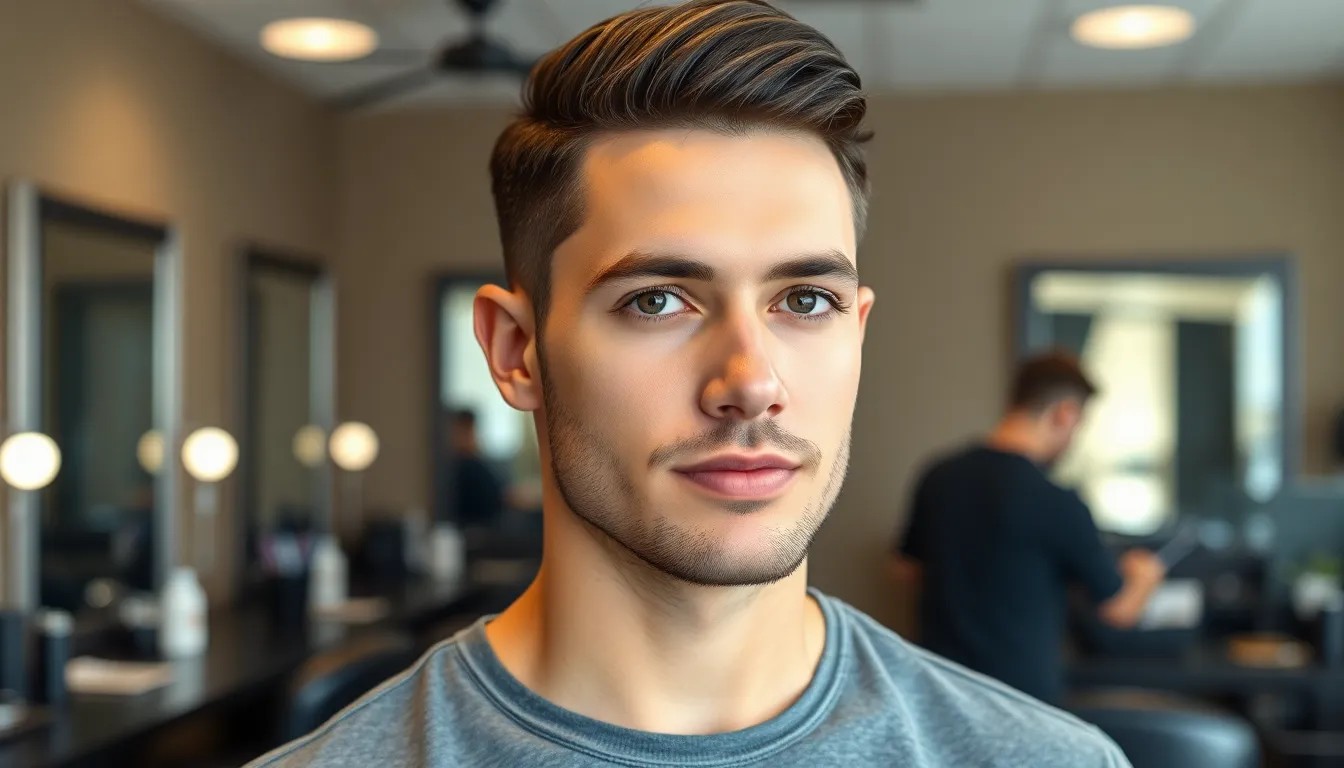
We’re witnessing a shift toward understated elegance in men’s grooming with minimalist single line accent cuts. These designs offer subtle sophistication through precise, narrow lines that complement professional and casual environments alike.
Simple Straight Line Through Fade
Simple straight line through fade creates bold statements with modern sophistication. This technique involves shaving a horizontal or vertical line directly across the faded area, producing sharp contrast between the smooth line and surrounding hair texture.
Placement options include:
- Temple area above the ear
- Back of the head across the fade
- Side sections following the natural hairline
We recommend this style for men seeking masculine edge without overwhelming complexity. The straight line works exceptionally well with various fade lengths, from high fades to low fades, creating visual depth and contemporary appeal.
Curved Single Line Following Head Shape
Curved single line following head shape introduces ever-changing movement by conforming to natural skull contours. This approach enhances facial features and cranial structure through strategic line placement that follows the head’s natural silhouette.
Key design elements:
- Curves mirror the side or back head shape
- Lines flow naturally with bone structure
- Subtle highlighting of facial features
We find this style particularly effective for men with strong jawlines or prominent cheekbones. The curved design softens angular features while maintaining masculine appeal, making it versatile for various face shapes and hair types.
Diagonal Line Accent on Short Hair
Diagonal line accent on short hair adds energy and movement to shorter hairstyles through strategic angular placement. This technique involves etching diagonal lines into sides or back areas, often intersecting with fades or undercuts for maximum visual impact.
Popular placement zones:
- Above the ear area
- Across temple regions
- Behind the head along fade lines
We execute these designs with precise clipper work, allowing customization in width, location, and complexity. The diagonal approach creates contemporary appeal while maintaining professional appearance, making it ideal for men who want distinctive style without excessive boldness.
Complex Multi-Line Artistic Designs
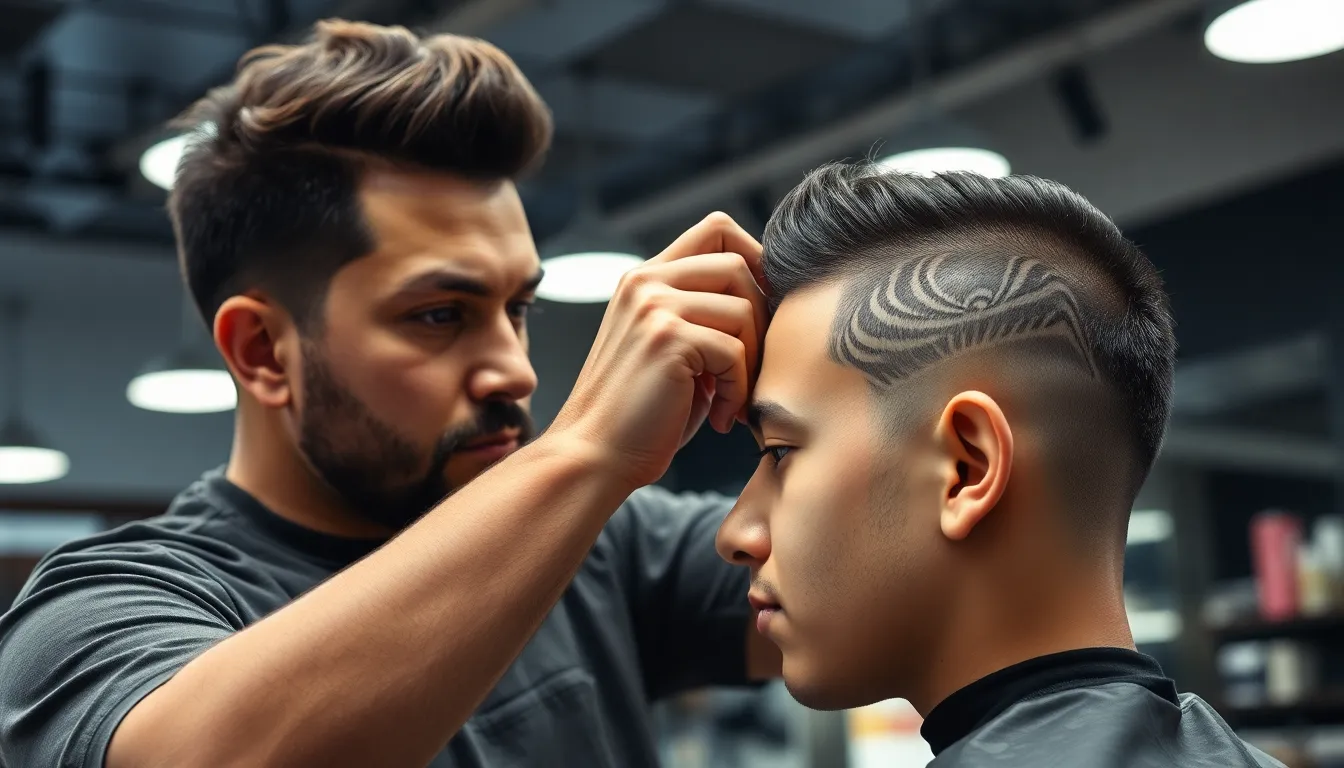
Building on the foundation of single line accents, we explore the area of intricate multi-line designs that transform haircuts into true artistic masterpieces. These sophisticated patterns require exceptional skill and attention to detail.
Parallel Lines Creating Layered Effects
Parallel lines create sophisticated layered effects that add depth and dimension to men’s haircuts. We see these designs most effectively implemented in geometric styles where multiple lines run alongside each other at consistent spacing. Barbers achieve this look by shaving or cutting parallel lines that create distinctive layered appearances, similar to the principles used in men’s cornrow braid styles where parallel braids deliver sleek symmetry.
Strategic placement of these parallel lines works best on the sides and back of the head. Multiple lines can range from two to five parallel cuts, depending on the desired intensity and hair length. Professional execution requires precise measurements to maintain consistent spacing between each line.
Maintenance schedules for parallel line designs typically require touch-ups every 2-3 weeks to keep the lines sharp and defined. We recommend discussing spacing preferences with your barber, as tighter parallel lines create more dramatic effects while wider spacing offers subtler results.
Intersecting Lines for Geometric Appeal
Intersecting lines create geometric patterns that add striking visual appeal through the strategic crossing of diagonal or curved lines. These designs form unique shapes that enhance facial features and create eye-catching geometric compositions. Z-shaped line designs represent one popular example of this technique, where intersecting lines create angular patterns that complement strong jawlines.
Complex intersections can incorporate multiple angles and curves that require advanced barbering skills to execute properly. We find these designs work exceptionally well with fade cuts, where the intersecting lines contrast beautifully against graduated hair lengths. Diamond patterns, triangular formations, and abstract geometric shapes all fall within this category.
Technical precision becomes crucial when creating intersecting line designs, as uneven angles or inconsistent depths can compromise the overall aesthetic. Professional barbers use specialized tools and techniques to ensure clean intersections that maintain their geometric integrity. Regular maintenance every 2-3 weeks preserves the sharp definition these designs require.
Tribal-Inspired Linear Patterns
Tribal-inspired linear patterns incorporate bold, symmetrical designs reminiscent of traditional tribal art into modern haircut aesthetics. These patterns feature complex line work that often includes cultural significance and symbolic meaning. We see increasing popularity for these designs as they offer both visual impact and personal expression opportunities.
Bold symmetrical designs characterize authentic tribal-inspired patterns, requiring skilled barbers who understand the cultural context and artistic principles behind these traditional motifs. Lightning-shaped freestyle designs add edgy touches to haircuts while maintaining respect for the tribal art inspiration. Complex geometric shapes, flowing curves, and interconnected line patterns all contribute to these striking designs.
Pinterest platforms showcase extensive collections of tribal-inspired haircut designs, demonstrating the wide range of geometric, freestyle, and culturally-influenced patterns available. These designs demand exceptional technical skill and artistic vision from barbers who specialize in intricate line work.
Cultural sensitivity remains important when choosing tribal-inspired patterns, as many designs carry traditional significance. We recommend researching the background of exact patterns and working with barbers experienced in these artistic styles to ensure respectful and authentic execution.
Line Designs for Different Hair Types and Textures
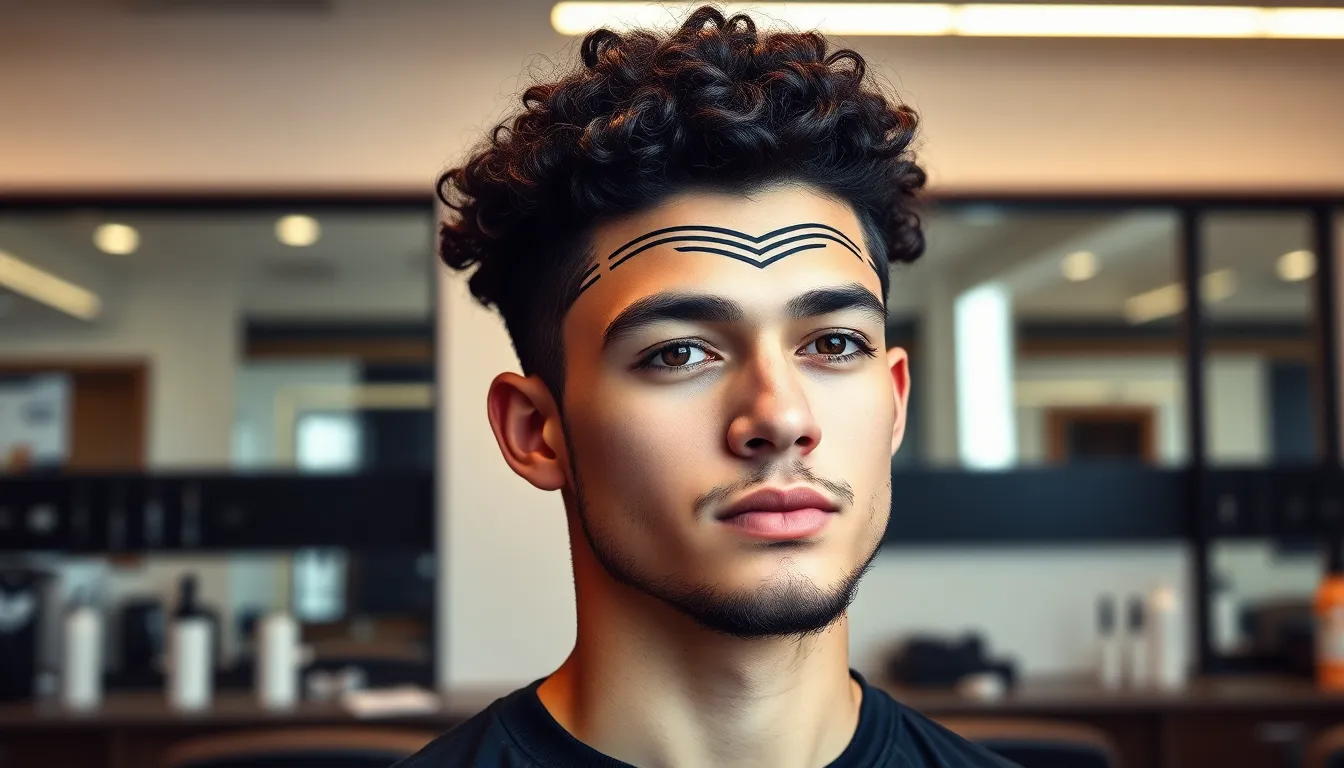
We’ve explored various line design styles, but understanding how these patterns work with different hair textures is crucial for achieving optimal results. Each hair type presents unique opportunities and challenges that require exact approaches to create stunning linear effects.
Line Cuts for Curly and Coily Hair
Minimalist line designs work best for curly and coily textures to preserve the natural curl pattern while adding definition. Soft, subtle lines complement the organic movement of curls without creating harsh contrasts that disrupt the hair’s natural flow.
Expert stylists specializing in textured hair are essential for achieving successful line designs on curly and coily hair. These professionals understand how curls behave and can strategically place lines to enhance rather than compete with the natural texture.
Single accent lines positioned along the temple area create striking effects without overwhelming the curl pattern. We recommend avoiding complex geometric patterns that can appear fragmented when combined with naturally textured hair.
Maintenance schedules for curly hair line designs typically require touch-ups every 3-4 weeks, as the growing curl pattern can quickly soften sharp lines. Using curl-defining products helps maintain the contrast between the lined areas and the textured sections.
Straight Hair Line Design Techniques
Straight hair offers maximum versatility for intricate line designs due to its smooth surface and predictable growth patterns. Geometric patterns, sharp angles, and bold linear statements achieve their cleanest appearance on straight textures.
Precision clippers and razors become essential tools for creating defined edges on straight hair. The smooth texture allows barbers to execute complex patterns with surgical precision, making straight hair ideal for detailed artistic expressions.
Bold geometric undercut patterns thrive on straight hair textures, creating stark contrasts between the lined sides and longer top sections. We’ve observed that straight hair maintains these sharp edges longer than other textures, extending the time between maintenance appointments.
Layered line effects work exceptionally well when multiple parallel lines are incorporated into straight hair fades. The uniform texture allows each line to remain distinct and visible, creating dramatic depth and dimension throughout the cut.
Wavy Hair Linear Pattern Adaptations
Wavy hair textures require balanced line designs that work harmoniously with the natural wave pattern rather than fighting against it. Flowing curved lines that follow the wave’s natural movement create the most successful results.
Geometric shapes can be adapted for wavy hair by incorporating softer edges and organic curves that complement the texture’s natural rhythm. Sharp angular patterns may appear disconnected from the hair’s inherent movement, so we recommend curved adaptations of traditional geometric designs.
Blending techniques become critical when working with wavy hair line designs. Skilled stylists must seamlessly transition between different lengths and textures to create cohesive looks that enhance the wave pattern while showcasing the linear elements.
Face shape considerations are particularly important for wavy hair line designs, as the natural texture can either enhance or diminish facial features depending on line placement. Strategic positioning of lines can create flattering frames that work with both the hair’s natural movement and the client’s bone structure.
Professional vs. DIY Line Design Approaches
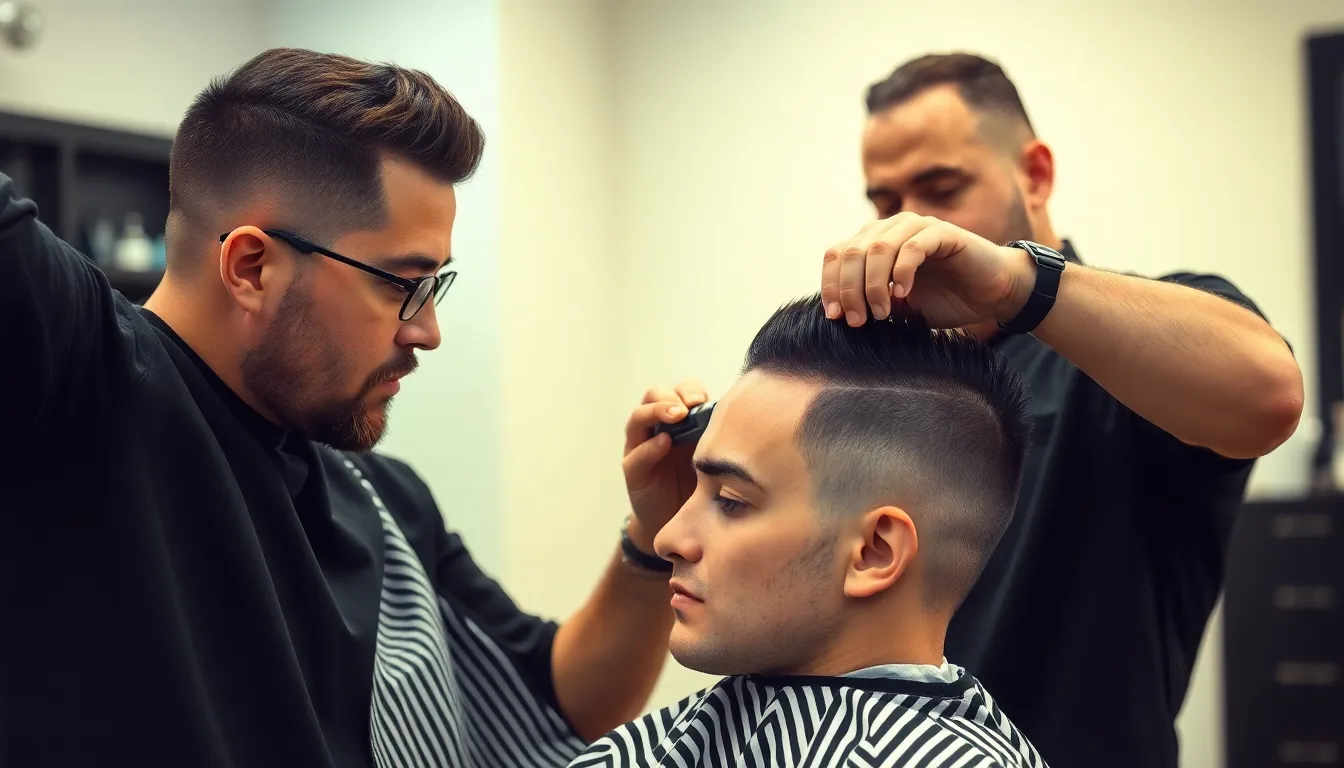
The choice between professional barbering and home cutting significantly impacts the precision and longevity of line designs in men’s haircuts. We’ll explore when each approach works best and how to maximize results regardless of your chosen method.
When to Visit a Professional Barber
Complex geometric patterns require the expertise that only professional barbers can provide, especially when incorporating intricate artistic patterns or sharp contrasts that demand advanced techniques. Professional barbers use razor-sharp clippers, straight blade razors, and specialized shears to achieve the level of precision needed for custom line designs that complement your facial structure.
Curved line designs present important challenges for DIY attempts, as professionals blend lines seamlessly using both curved and straight techniques that create polished, finished looks. We recommend visiting a barber when updating classic or trendy styles, rectifying previous cutting mistakes, or working with sensitive skin that requires careful handling.
Regular maintenance visits help preserve the sharpness and integrity of line designs over time, ensuring your investment in professional work continues to look fresh. Professional barbers also excel at creating geometric shapes and artistic patterns that would be nearly impossible to achieve at home without years of training.
Basic Line Techniques for Home Cutting
Simple straight lines work best for DIY approaches, particularly around the temples or ears where mistakes are less noticeable and easier to correct. We suggest using a comb to guide horizontal lines rather than relying on your fingers, which can introduce errors and create uneven results.
Starting positions should focus on areas like the hairline or around the edges, where basic clippers with guards can maintain consistent lengths without requiring advanced blending skills. Use a mirror to check symmetry throughout the cutting process, as this prevents major mistakes that would require professional correction.
Natural hair fall should guide your cutting technique rather than elevating the hair too much, which can distort the final appearance and result in uneven cuts. Home cutting works well for maintaining existing professional work between barber visits but shouldn’t be your primary method for creating new line designs.
Tools and Equipment for Line Designs
| Tool Type | Professional Grade | DIY Home Use |
|---|---|---|
| Primary Cutting | Razor-sharp clippers with multiple attachments | Quality clipper or trimmer with basic guards |
| Detail Work | Straight blade razors and specialized shears | Trimmers with detail attachments |
| Guidance Tools | Professional combs and sectioning tools | Fine-toothed comb and handheld mirror |
| Advanced Options | Custom stencils and pattern guides | Basic stencils for beginners |
Essential equipment for home users includes at least a quality clipper or trimmer, a fine-toothed comb, and a good mirror for checking your work from multiple angles. Professional setups require precision clippers, trimmers with detail attachments, sharp shears, and straight razors for advanced techniques.
Cordless adjustable trimmers offer enhanced control and ease of use for both professionals and DIY users, making them worthwhile investments for anyone serious about line design maintenance. Stencils or guides can assist beginners with accurate patterning, though they shouldn’t replace proper technique development over time.
Maintenance and Styling Tips for Line Haircuts

Professional line designs require consistent care to maintain their sharp appearance and visual impact. We’ll explore essential maintenance routines that keep your line cuts looking fresh between barber visits.
Daily Styling Routines for Sharp Lines
Daily grooming forms the foundation of maintaining crisp line haircuts. We recommend starting each morning with clean hair, using a shampoo and conditioner suited to your exact hair type to create the ideal base for styling.
Combing or brushing your hair daily prevents tangles and helps maintain the structured appearance of your line designs. Leave-in conditioners or hair oils provide healthy shine while minimizing frizz, which helps keep the edges of your line-up smooth and well-defined.
Styling products like pomades or clays define and hold your line-up in place throughout the day. We suggest applying these products with precision, focusing on the areas around your line designs to emphasize their sharpness and maintain their architectural quality.
Regular neck hair trimming and removing excess ear and eyebrow hair enhances the overall look of your haircut. These grooming details complement your line designs and create a polished, cohesive appearance that elevates your entire style.
Touch-Up Frequency and Techniques
Touch-ups every 2-4 weeks maintain the crispness of your line designs, though frequency depends on your hair growth rate and desired sharpness level. Fast-growing hair may require more frequent maintenance to preserve the precision of geometric patterns and clean edges.
Professional barber visits ensure the most precise touch-ups, especially for complex geometric patterns and intricate multi-line designs. We recommend consulting with experienced barbers who understand the technical requirements of maintaining your exact line style.
DIY trims at home can help maintain sharp lines between professional appointments, but we advise limiting home maintenance to simple straight lines only. Basic touch-up tools and steady hands allow for minor edge cleaning, though complex patterns should remain in professional hands.
Regular trimming keeps hairstyles identifiable and maintains the sharp lines that define your look. We emphasize that consistent maintenance schedules prevent line designs from losing their visual impact and architectural precision.
Products That Enhance Line Definition
Pomades excel at defining and holding sharp lines while providing the control needed for precise styling. We recommend choosing pomades based on your desired finish, whether you prefer high-shine or matte appearances for your line designs.
Edge control products specifically target hairline definition, keeping edges in place throughout the day. These specialized formulas work particularly well for maintaining the crispness of temple lines and geometric patterns around the hairline.
Hair oils enhance shine and minimize frizz, helping maintain a polished look that complements sharp line work. We suggest using lightweight oils that won’t weigh down your hair or interfere with the precision of your line designs.
Quality styling tools complement the right products in achieving professional results. Precision clippers, fine-tooth combs, and edge brushes work together with your chosen products to maintain the sharp definition that makes line haircuts stand out.
Conclusion
We’ve explored how line designs transform ordinary haircuts into artistic statements that reflect personal style and confidence. From classic line-ups to intricate geometric patterns these techniques offer endless possibilities for self-expression.
Whether you’re drawn to minimalist single lines or bold tribal-inspired patterns the key lies in choosing designs that complement your hair type and lifestyle. Professional execution remains crucial for achieving sharp precise results that last.
Remember that maintaining these distinctive looks requires dedication and the right products. With proper care and regular touch-ups your line design will continue making that powerful statement you’re after.
Frequently Asked Questions
What are line designs in men’s haircuts?
Line designs are artistic patterns shaved or cut into men’s hair using precise lines, geometric shapes, and creative patterns. They range from simple straight lines to complex geometric designs, zigzag patterns, and tribal-inspired motifs. These designs transform ordinary haircuts into artistic statements, allowing for personal expression while maintaining a sharp, professional appearance.
How often should I maintain my line design haircut?
Line design haircuts require touch-ups every 2-4 weeks to maintain their sharp appearance. Daily grooming with appropriate products is essential, and professional barber visits are recommended for complex patterns. Simple designs may be maintained longer, but regular neck hair trimming helps preserve the overall crispness of the cut.
Can line designs work with all hair types?
Yes, but the approach varies by hair type. Curly and coily hair work best with minimalist designs that preserve natural curl patterns. Straight hair offers maximum versatility for intricate geometric patterns. Wavy hair requires balanced designs that harmonize with natural wave patterns. Professional consultation is recommended for optimal results.
Should I get line designs done professionally or attempt DIY?
Complex line designs require professional barbering expertise for precise execution and artistic quality. Simple straight lines can be attempted at home with proper tools like quality clippers, guards, and mirrors. However, geometric patterns, tribal designs, and intricate multi-line work should always be done by experienced barbers to avoid mistakes.
What products help maintain line design haircuts?
Essential products include sulfate-free shampoos, lightweight conditioners, pomades or styling clays for definition, and edge control products for crisp lines. Hair oils add shine and moisture, while quality styling tools like fine-tooth combs and boar bristle brushes help achieve professional results. Choose products based on your specific hair type and texture.
What are the most popular line design styles currently?
Popular styles include classic straight edge line-ups, geometric undercut patterns, zigzag temple lines, ocean wave designs, and minimalist single line accents. Modern trends favor creative combinations of fades with precision line work, angular side parts, and abstract linear designs on faded sides for contemporary artistic expression.
